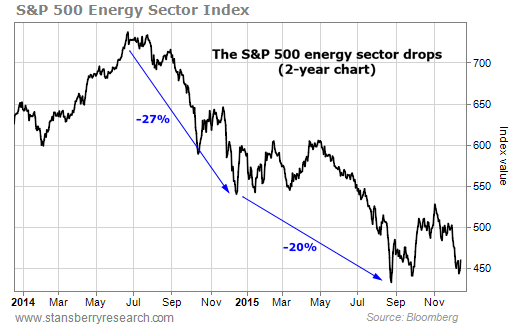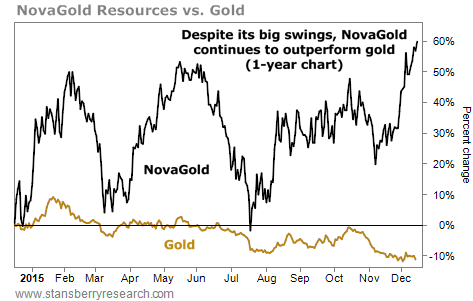| Home | About Us | Resources | Archive | Free Reports | Market Window |
Getting This Wrong Could Be Devastating to Your WealthBy
Wednesday, December 16, 2015
In the past few years, an important market principle has proven itself over and over and over.
Get it right... and you could make tremendous amounts of money.
Get it wrong... and you could lose a fortune.
This idea is so important, you may want to print out the following quote and tape it to your computer monitor. It comes from legendary trader Jim Rogers:
Markets often rise higher than you think is possible and fall lower than you can possibly imagine.
Today, we'll look at a few ways this idea is playing out in the market right now. We'll show you two simple ways to get this idea right... And we'll share two simple ways to avoid getting it wrong.
We'll start off with the first part of Rogers' quote: Markets often rise higher than you think is possible.
Lots of folks have been predicting a bear market in stocks for years. This type of market prediction is almost always useless... But trying to prevent yourself from having opinions about the markets is useless, too.
The important thing is what you do with these opinions...
Folks who pulled their money out of stocks during the 2010 correction, the 2011 correction, or the 2012 correction have missed out on enormous gains. And as our colleague Steve Sjuggerud pointed out last week, folks who have pulled their money out of stocks today could miss out on big gains to come.
So, what do you do if you think the market is about to fall off a cliff?
First off, use stop losses, always, on every position. A stop loss is a predetermined point at which you'll sell a trading position. When you use stop losses, the market tells you when to exit a position. There's no emotion or opinion involved... except when you decide how much "wiggle room" you want to give your position. And you should make that decision before opening the trade or investment.
Second, take a look at the long-term trend as a way to guide your behavior. We like using the 200-day moving average, which is a widely used gauge of the long-term trend. It's calculated by taking the average of an asset's closing prices from the past 200 days. As each day passes, the most recent day's closing price is included in the average... And the oldest day's price (now day 201) gets dropped.
The chart below shows the benchmark S&P 500 Index – along with its 200-day moving average – over the last 10 years. Right now, the index is just a bit below its 200-day moving average.
 There are two things to consider when looking at the 200-day moving average:
After peaking in August, the 200-day moving average has drifted a little lower. This tells us it's a good time to be cautious with new stock purchases. Now, let's look at the second part of Rogers' quote: [Markets often] fall lower than you can possibly imagine.
This part is tough to get right for even the smartest traders and investors. Everyone seems to have a grand desire to call the exact bottom... to be exactly right.
It's a mistake. The risks far outweigh the benefits.
The energy sector provides a great example. Huge supplies of oil and natural gas, along with a sluggish global economy, have led to falling energy prices. And energy-related stocks have fallen along with them.
From its peak in the summer of 2014 through mid-December 2014, crude-oil prices fell 48%. The S&P 500 Energy Sector Index – a diversified group of energy stocks – fell 27%. When the stocks stopped falling, lots of brilliant investors piled in.
But look at what happened next. After trading sideways for six or seven months, the Energy Sector Index dropped another 20% from its previous low.
 For folks who put a lot of money into energy stocks, the mistake was costly. So, what do you do if you think a market is oversold, cheap, and ready to scream higher?
First, you wait for an uptrend to begin. An uptrend is nothing more than a series of higher highs and higher lows. When you wait for the start of an uptrend, you won't catch the exact bottom... But you take a lot less risk. An uptrend shows that the market has started to agree with your views.
And second, if you can't wait for that uptrend, be sure to only "dip a toe in." Keep your position size small. (And again, use stop losses.) Even a big drop won't be too painful if you only have a small portion of your wealth allocated to that idea.
If you're right and the asset does start to trend higher, then you can go ahead and add to your position.
It's still too early to say for sure that the energy sector has hit bottom and begun to trend higher. But we do have a couple of "higher lows." You can dip your toe into the sector... But it's best to wait for a better uptrend to take shape before putting big money into energy stocks.
So, the takeaway here:
If you've pulled your money completely out of stocks... or if your mouth is watering over a beaten-down sector, like energy... let Rogers' quote serve as a warning.
Markets often rise higher than you think is possible and fall lower than you can possibly imagine.
Regards,
Brian Hunt and Ben Morris
Further Reading:
Check out Brian and Ben's other big ideas in Growth Stock Wire right here:
"There's lots of upside to come in U.S. housing stocks..."
"Today, we're looking at the stock market from two different vantage points."
"It could be a radically new way for you to view your investment account... and it could transform your investing for the better."
Market NotesTHIS GOLD STOCK IS HITTING NEW HIGHS Today, we turn our attention to one of the few big uptrends in the gold market right now...
Regular readers know Steve has been bullish on gold and gold stocks over the past few months. In October, he wrote that gold stocks are record cheap... and were offering the exact setup he looks for when investing. But while the sector continues to whipsaw back and forth, one stock has far outperformed its peers.
We're talking about small-cap gold miner NovaGold Resources (NG). NovaGold owns 50% of one of the world's highest-quality gold mines, Alaska's Donlin Gold mine. The Donlin is one of a small handful of mines in the world capable of producing more than 1 million ounces of gold a year.
As you can see from the chart below, NovaGold just rallied to a fresh 52-week high. And while it has been a volatile ride for investors overall, the company has outperformed gold in a big way over the past year. While gold prices are down more than 10% in 2015, NovaGold shares are up nearly 50%...
 |
Recent Articles
|



